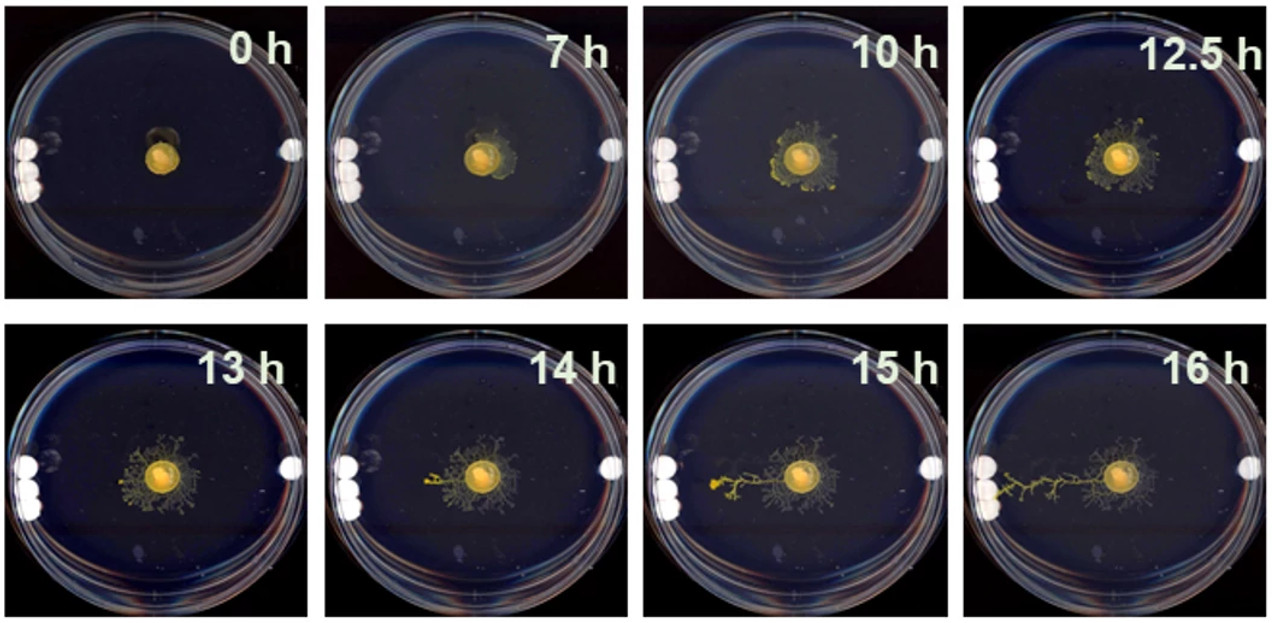People often throw around the word “brainless” as an insult, but the slime mold Physarum polycephalum, which literally has no brain, might make us rethink this characterization. This blob-like lifeform can perform surprisingly complex calculations, such as solving mazes or exhibiting basic forms of memory.
To learn more about how Physarum molds make smart decisions with no brain, researchers from the Wyss Institute at Harvard University and the Allen Discovery Center at Tufts University tested their environmental awareness. The results revealed a “novel preference and sensing capability in the unicellular organism” in which the mold uses its body as “both a distributed sensor array and computational substrate,” according to a study published on Thursday in Advanced Materials.
Videos by VICE
These abilities open a new window into the intelligence of a brainless (or “aneural”) organism, but they also provide insights about behavioral capabilities throughout the tree of life, and can inform the development of soft robotics, artificial neural networks, and other bioengineering applications.
“[Physarum] doesn’t have any neural systems inside of it; it’s basically one gigantic cell that grows,” said first author Nirosha Murugan, an assistant professor at Algoma University and a former member of the Allen Discovery Center, in a call. “People are using Physarum more in the world of cognition because you can read out its decision in its body,” meaning that the organisms’ “thinking” process is expressed by its body shape.
“What’s cool about Physarum is that its decision-making behavior is its morphogenesis,” added senior author Mike Levin, a Wyss Associate Faculty member and director of the Allen Discovery Center, in the same call. “It ends up being a very nice intersection point between decision-making in three-dimensional space, which is behavior, and decision-making in morphological space and patterning” in which it is “a swarm intelligence of cells trying to build something.”
To observe this decision-making process in action, the team placed the slime molds at the center of petri dishes that contained a small disc at one end, and three discs spread out next to each other on the opposite side. Over the course of about 12 hours, the Physarum expanded outwards in all directions; after that, it appeared to make a concerted decision to invest its resources into exploring the side with three discs 70 percent of the time. Even though it had not directly reached the discs, the researchers concluded that the mold could sense the greater strain produced by the larger set of objects there, indicating that this side of the dish was an area that should be preferentially explored.
“It was really obvious that they chose a heavier mass on one side,” Murugan said. “It was unexpected how obvious it was—I thought it would be a little bit more muddied than that.”

The researchers also discovered that a heavier mass was not the only factor in the mold’s problem-solving approach. When the three discs were stacked on top of each other as opposed to spread out along the dish wall, the Physarum no longer showed a clear preference between one side or the other, indicating that it sought out patterns of strain rather than just an intense mass signal.
Unlike previous studies with slime molds, the new experiments did not involve food or chemical signals, which helped the team isolate the mechanical clues that Physarum reads from its environment that are independent from feeding incentives that influence its behavior. This approach revealed that the slime molds appear to spend time considering their options before making a decision about where to send resources.
“Because we don’t have any chemical sources, we can truly see how this thing is thinking, or what it is using to think,” Murugan said. “What we see is that in its initial thinking or ‘buffering’ stage, as I think about it, it’s using information from its environment from a biophysical point of view, by tugging or sensing the actual substrate, and then processing that information and growing towards the higher mass strain, or strain angle.”
The researchers further investigated Physarum’s thinking abilities by targeting special “TRP-like” proteins, which are known to mediate mechanosensory systems in cell membranes. When the slime molds were exposed to a drug that blocks the TRP channel, they were no longer able to tell the difference between the regions with high and low masses.
Similarly, when the team shook the dishes, thus introducing noisy mechanical signals, the molds lost their ability to navigate toward a preferred target. These variations of the experiment strongly suggest Physarum has evolved “a fundamentally novel method of mechanosensation,” according to the study.
The study sheds new light on the evolution of aneural organisms as well as the potential replication of their abilities in robotics or neural networks. The mechanosensory abilities of these slime molds are also similar to those of somatic cells, including neurons, so they can inform studies of brains, even though they lack them.
Physarum “might actually give us insights into other kinds of intelligence,” Murugan said. “Its ability to read its environment is important, so I think making a note of that is something exciting about Physarum.”
More
From VICE
-

Screenshot: Sony Interactive Entertainment -

-

LOS ANGELES, CALIFORNIA – NOVEMBER 14: Timothée Chalamet seen at a Special Screening of A24's "Marty Supreme" at Academy Museum of Motion Pictures on November 14, 2025 in Los Angeles, California. (Photo by Eric Charbonneau/A24 via Getty Images) -

Photo: Gandee Vasan / Getty Images
